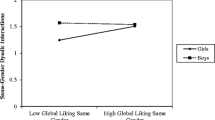Abstract
This study examined childrens' stereotypes about sex differences in emotionality. Thirty preschoolers were presented with hypothetical emotional situations and asked to indicate the gender of the expressor and reasons for their choice. Although fear was consistently associated with females, gender attribution was situation specific for anger and happiness. Examination of preschoolers' explanations for gender attributions revealed that females made greater use of sex-role and imagery categories than did males. Furthermore, a significant age difference in the use of categorical and noncategorical responses was reported, with younger children making a greater number of noncategorical explanations. Children who used imagery to mediate gender choice relied primarily on hair color and length as gender-specific cues.
Similar content being viewed by others
References
Barry, R. J. Stereotyping of sex-role in preschoolers in relation to age, family structure, and parental sexism. Sex Roles, 1980, 6, 795–806.
Best, D. L., Williams, J. E., Cloud, J. M., Davis, S. W., Robertson, L. S., Edwards, J. R., Giles, H., & Fowles, J. Development of sex-trait stereotypes among young children in the United States, England, and Ireland. Child Development, 1977, 48, 1375–1384.
Birnbaum, D. W., Nosanchuk, T. A., & Croll, W. L. Children's stereotypes about sex differences in emotionality. Sex Roles, 1980, 6, 435–443.
Brigham, J. C. Ethnic stereotypes. Psychological Bulletin, 1971, 76, 15–38.
Condry, J., & Condry, S. Sex differences: A study of the eye of the beholder. Child Development, 1976, 47, 812–819.
Cowan, M. L., & Stewart, B. J. A methodological study of sex stereotypes. Sex Roles, 1977, 3, 205–216.
Koblinsky, S. G., Cruse, D. F., & Sugawara, A. I. Sex role stereotypes and children's memory for story content. Child Development, 1978, 49, 452–458.
Kuhn, D., Nash, S. C., & Brucken, L. Sex role concepts of two- and three-year-olds. Child Development, 1978, 49, 445–451.
Rosenkrantz, P. S., Vogel, S. R., Bee, H., Broverman, I. K., & Broverman, D. M. Sex-role stereotypes and self-concepts in college students. Journal of Consulting and Clinical Psychology, 1968, 32, 287–295.
Silvern, L. E. Children's sex-role preferences: Stronger among girls than boys. Sex Roles, 1977, 3, 159–171.
Thompson, S. K., & Bentler, P. M. The priority of cues in sex discrimination by children and adults. Developmental Psychology, 1971, 5, 181–185.
Williams, J. E., Bennett, S. M., & Best, D. L. Awareness and expression of sex stereotypes in young children. Developmental Psychology, 1975, 1, 635–642.
Author information
Authors and Affiliations
Rights and permissions
About this article
Cite this article
Birnbaum, D.W., Chemelski, B.E. Preschoolers' inferences about gender and emotion: The mediation of emotionality stereotypes. Sex Roles 10, 505–511 (1984). https://doi.org/10.1007/BF00287259
Issue Date:
DOI: https://doi.org/10.1007/BF00287259




